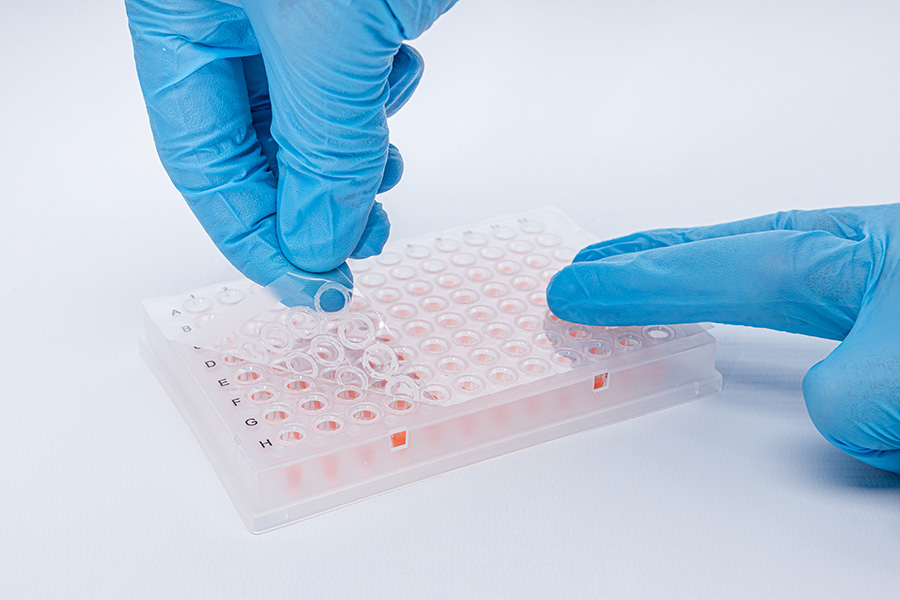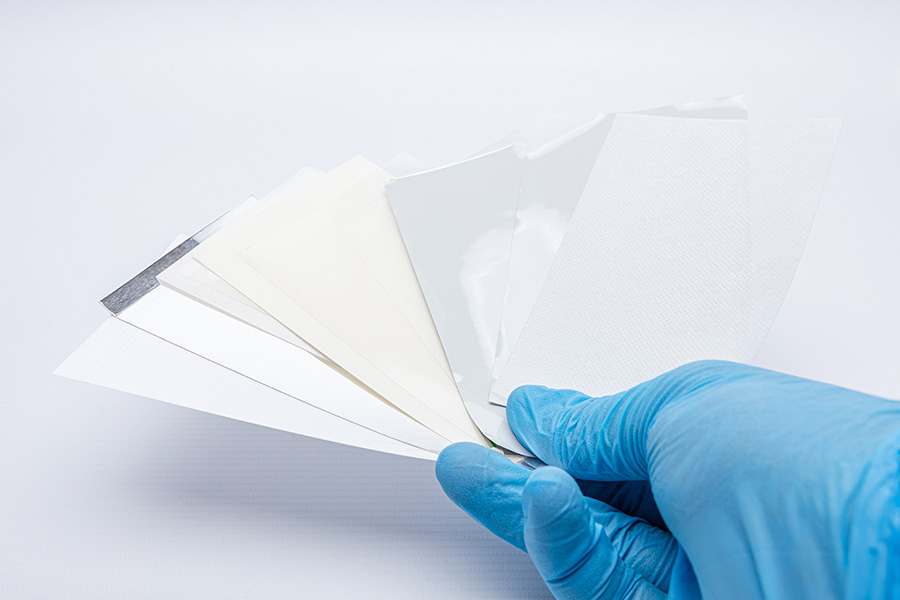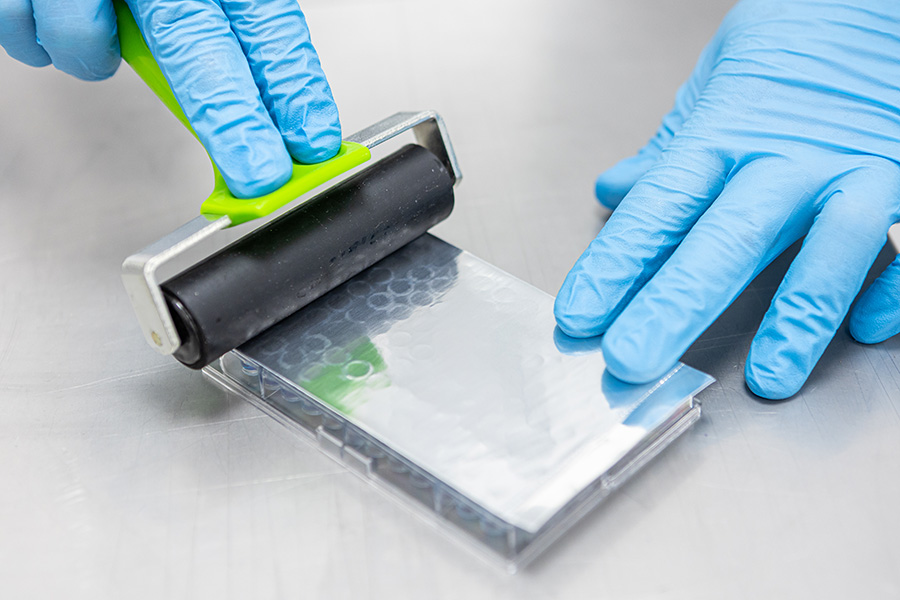Blog
Pros and Cons of Film Seals and Foil Seals for Microplates
Pros and Cons of Film and Foil Seals: Everything you need to know.
Microplates are a convenient, high-throughput method for storing, transporting and handling compounds and samples, but they have common problems associated with them.
Evaporation can occur from the wells of the plate which can affect concentration readings. Contamination from dust, spores or other atmospheric detritus may occur and spillage is a constant danger whenever microplates are used for transport.
Add to this the general risks of cross-contamination in the denser formats such as 96-well plates and 384-well plates and it is easy to see why a sealing closure of some sort is important.
Microplate sealing films and tape protect well contents from leakage, contamination, and evaporation during assay processing, incubation, or storage.
Choosing the correct combination of microplate sealing for each type of microplate is important to achieving the best laboratory practice and avoiding unnecessary work further downstream.
Film seals and foil seals are two popular choices for sealing microplates. In this article, we will look at the pros and cons of both types of seals to help you determine which one is right for your laboratory needs.
What are Microplate Sealing Films?
Microplate sealing films are a thin plastic layer with an additional sealing coating that is either adhesive or that melts when heat is applied to form a tight seal with the rims of each well.
Film seals are a good choice for optical analysis as they are transparent and robust enough to protect samples and prevent evaporation or contamination.
Microplate sealing films come in various thicknesses and widths to fit different microplates. Let’s take a look at the pros and cons of film seals used to seal microplates.
What are the Pros of Microplate Sealing Films?
Film seals are inexpensive and easy to use. They can be applied quickly and effectively, which makes them ideal for high-throughput microplate applications.
The adhesive backing of the film ensures a tight fit on microplates, while its flexibility ensures that it can easily conform to different microplate sizes and shapes. Film seals also provide excellent protection against evaporation and contamination.
Some additional pros of using film seals to seal microplates include:
– Easy to use and remove
– Cost-effective for short runs
– Available in a variety of thicknesses and widths
– Air-tight seals are formed when heated
– Inert materials with good temperature resistance
– Low profile after application
– Compatible with automated sealing processes
What are the Cons of Microplate Sealing Films?
One of the main disadvantages of using sealing films is that they can be difficult to remove from microplates without leaving residue. In addition, certain types of sealant films may not be compatible with plastic microplates if exposed to harsh temperatures, chemicals, or conditions. Finally, film seals are not as durable as foil seals and may be prone to breakage.
Some of the cons of using film seals to seal microplates may include:
– Not suitable for long-term storage or extended incubations
– The adhesive can become brittle over time and may break off when removed from plates
– Heat-sealing films can cause plate warping when not applied properly.
When to / not to use Microplate Sealing Films:
- Film seals are appropriate for PCR and qPCR.
- Film seals are not recommended for storage below -80℃.
- If you need long-term storage of samples, heat sealing film is a good choice as the heat creates a very robust seal.

What are Microplate Sealing Foils
Microplate sealing foils offer another way to protect microplate contents from contamination and evaporation. Foil seals consist of a thin layer of aluminium foil attached to a carrier material, such as paper or plastic.
The aluminium is heat-sealed onto the top surface of the plate forming an airtight seal that prevents evaporation, leakage, and contamination.
Let’s take a look at the pros and cons of sealing foils used to seal microplates.
Pros of Microplate Sealing Foils
Foil seals are highly resistant to temperatures and chemicals, and are more suitable for long-term storage or extended incubations. They also create a strong barrier against moisture and oxygen, helping to extend the shelf life of products.
Some additional pros of using sealing foils to seal microplates include:
– Easy to apply and remove without causing microplate warping
– Good adhesion even after repeated microplate handling
– Cost-effective for high sample throughput applications
– Flexible material that can accommodate different well-plate sizes and shapes
– Allows for easy sample retrieval when needed
Cons of Microplate Sealing Foils
While sealing foils offer a number of advantages for microplates, there are also some potential drawbacks to consider. One concern is that sealing foils can be difficult to remove, which can make it difficult to access the wells for sampling or other purposes.
Some additional cons of using microplate sealing foils include:
– More expensive than film seals
– Can be difficult to remove from the microplate without damaging the wells- Can easily tear or puncture when handled improperly

When to use film seals or foil seals
When microplates need to be sealed for long-term storage or extended incubations, sealing foils are the best option. Microplate sealing foil provides a secure seal that can withstand extreme temperatures and chemicals; they also won’t curl up over time like film seals. Sealing foil is also ideal for light-sensitive samples as the foil effectively shields samples from light.
On the other hand, if you require only short-term storage for quick assays, then film seals are the ideal choice as they are easier to apply and remove without causing microplate warping. They will effectively prevent contamination and evaporation while withstanding moderate temperature and chemical stress.
Both types of microplate sealing materials offer excellent protection against evaporation, leakage, and contamination when used properly. It is important to select the right type of microplate sealing material so that your results will not be compromised by using an inappropriate seal.

Which is the best sealing film for cold storage?
Foil seals are the best choice for cold storage as they provide a secure and airtight seal that protects samples from contamination, evaporation, and leakage.
Foil seals are also flexible enough to accommodate different well sizes and shapes, so it’s easy to find one to fit your specific needs. Finally, foil seals can withstand extreme temperatures better than film seals, making them an ideal option for long-term cold storage applications.
Which sealing film is the best to re-seal?
When re-sealing microplates, it is important to choose a film that is designed for resealability. Films such as adhesive sealing films and peelable sealing films offer the highest levels of resealability and are also very easy to apply and remove without damaging microplates.
Additionally, some microplate seaming systems provide automated solutions for quickly re-sealing microplates with minimal effort. This makes them an ideal choice for laboratories that require frequent microplate re-seals.
Ultimately, the best microplate sealing film for your needs will depend on your budget and application requirements. Once you have evaluated these factors, you can find the right sealing film for your laboratory’s needs.

Final Thoughts on the Pros and Cons of Microplate Sealing Films and Sealing Foils
Knowing the pros and cons of both sealing film and sealing foil can help you make an informed decision about which microplate seal is right for your laboratory needs.
Both microplate sealing films and sealing foils are effective ways to protect microplate contents from contamination, evaporation, and leakage.
- Film seals provide an inexpensive solution that is easy to use and ideal for high-throughput microplate applications.
- Foil seals, on the other hand, offer a secure seal suitable for long-term storage or extended incubations but require additional equipment and expertise to apply correctly.
In either case, selecting the right type of microplate sealing material and technique is essential for achieving the desired results – ensuring that the microplate is properly sealed in order to preserve its contents and maintain sample integrity.
Ultimately the decision comes down to cost, convenience, and how long you need your plate sealed. Whichever way you go, make sure you choose the right sealing material for your lab’s specific needs.
iST Scientific has a range of options for you to consider when it comes to microplate sealing. We have both adhesive and non-adhesive types available, so you can pick the perfect product for your needs. If you are unsure which one is best, our team can advise you. We have many years of experience in the industry and are always happy to help.
For more information on sealing microplates, please contact one of our experts today. We can provide advice and recommendations based on your specific application requirements.

